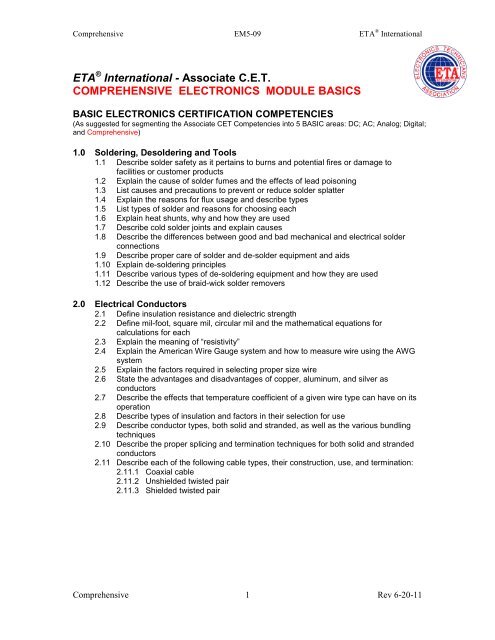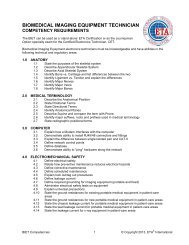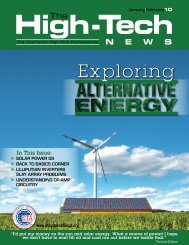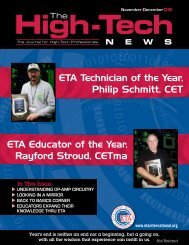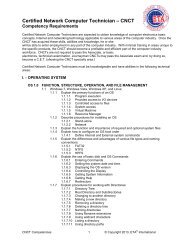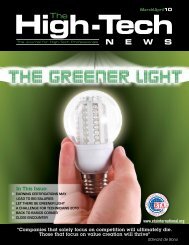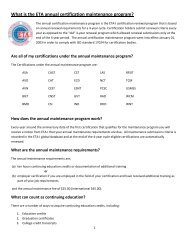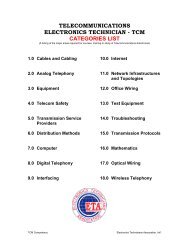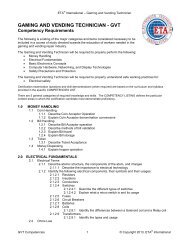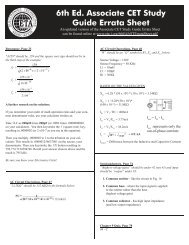EM5 - ETA International
EM5 - ETA International
EM5 - ETA International
Create successful ePaper yourself
Turn your PDF publications into a flip-book with our unique Google optimized e-Paper software.
Comprehensive <strong>EM5</strong>-09 <strong>ETA</strong> ® <strong>International</strong><br />
<strong>ETA</strong> ® <strong>International</strong> - Associate C.E.T.<br />
COMPREHENSIVE ELECTRONICS MODULE BASICS<br />
BASIC ELECTRONICS CERTIFICATION COMPETENCIES<br />
(As suggested for segmenting the Associate CET Competencies into 5 BASIC areas: DC; AC; Analog; Digital;<br />
and Comprehensive)<br />
1.0 Soldering, Desoldering and Tools<br />
1.1 Describe solder safety as it pertains to burns and potential fires or damage to<br />
facilities or customer products<br />
1.2 Explain the cause of solder fumes and the effects of lead poisoning<br />
1.3 List causes and precautions to prevent or reduce solder splatter<br />
1.4 Explain the reasons for flux usage and describe types<br />
1.5 List types of solder and reasons for choosing each<br />
1.6 Explain heat shunts, why and how they are used<br />
1.7 Describe cold solder joints and explain causes<br />
1.8 Describe the differences between good and bad mechanical and electrical solder<br />
connections<br />
1.9 Describe proper care of solder and de-solder equipment and aids<br />
1.10 Explain de-soldering principles<br />
1.11 Describe various types of de-soldering equipment and how they are used<br />
1.12 Describe the use of braid-wick solder removers<br />
2.0 Electrical Conductors<br />
2.1 Define insulation resistance and dielectric strength<br />
2.2 Define mil-foot, square mil, circular mil and the mathematical equations for<br />
calculations for each<br />
2.3 Explain the meaning of “resistivity”<br />
2.4 Explain the American Wire Gauge system and how to measure wire using the AWG<br />
system<br />
2.5 Explain the factors required in selecting proper size wire<br />
2.6 State the advantages and disadvantages of copper, aluminum, and silver as<br />
conductors<br />
2.7 Describe the effects that temperature coefficient of a given wire type can have on its<br />
operation<br />
2.8 Describe types of insulation and factors in their selection for use<br />
2.9 Describe conductor types, both solid and stranded, as well as the various bundling<br />
techniques<br />
2.10 Describe the proper splicing and termination techniques for both solid and stranded<br />
conductors<br />
2.11 Describe each of the following cable types, their construction, use, and termination:<br />
2.11.1 Coaxial cable<br />
2.11.2 Unshielded twisted pair<br />
2.11.3 Shielded twisted pair<br />
Comprehensive 1 Rev 6-20-11
Comprehensive <strong>EM5</strong>-09 <strong>ETA</strong> ® <strong>International</strong><br />
3.0 AC Power Distribution<br />
3.1 Describe the design of both single phase and multiphase AC power distribution<br />
3.2 Describe the typical use of both single phase and multiphase AC power distribution<br />
3.3 Describe the typical control and circuit protection devices used for AC power<br />
distribution<br />
4.0 Circuit Protection<br />
4.1 Describe the physical design of fuses and their current and voltage rating systems<br />
4.2 Describe the numbering marking system used with fuses and their schematic<br />
symbols<br />
4.3 Describe the physical design and current and voltage rating system of circuit<br />
breakers<br />
4.4 Describe the numbering marking system used with circuit breakers and their<br />
schematic symbols<br />
5.0 Circuit Controls<br />
5.1 List the general types of circuit control devices and their use<br />
5.2 Identify the schematic symbol for a switch, solenoid, and relay<br />
5.3 Describe the operating principles and characteristics of a solenoid, relay, and switch<br />
5.4. State the meaning of current and voltage ratings for a switch, solenoid, and relay<br />
6.0 Generators<br />
6.1 DC generators<br />
6.1.1 State the principal by which generators convert mechanical energy to<br />
electrical energy<br />
6.1.2 State the left hand rule for generators<br />
6.1.3 Explain the process of commutation in DC Generators<br />
6.1.4 Describe the design and operation of a DC generator<br />
6.1.5 Describe the voltage and current variation from no load to full load in a DC<br />
generator<br />
6.1.6 Describe how and why field strength can and may be varied in a DC<br />
generator<br />
6.1.7 Describe the construction and operation of series wound, shunt wound, and<br />
compound wound generators<br />
6.2 AC generators<br />
6.2.1 Describe the principle of magnetic induction as it applies to AC generators<br />
6.2.2 Describe the construction and operation of both rotating-armature and<br />
rotating-field alternators, and the advantages of each design<br />
6.2.3 Describe the construction and operation of single-phase, two-phase, and<br />
three phase alternators<br />
6.2.4 Describe the construction, operation and advantage of both delta and wye<br />
three-phase connections for AC generators<br />
6.2.5 Explain the principles of voltage control with AC generators<br />
Comprehensive 2 Rev 6-20-11
Comprehensive <strong>EM5</strong>-09 <strong>ETA</strong> ® <strong>International</strong><br />
7.0 Motors<br />
7.1 DC motors<br />
7.1.1 State the factors that determine the direction of rotation of DC motors.<br />
7.1.2 State the right hand rule for motors<br />
7.1.3 Explain the process of commutation in DC motors<br />
7.1.4 Describe the construction and operational characteristics of series, shunt,<br />
and compound DC motors<br />
7.1.5 Describe speed and direction control techniques for DC motors<br />
7.2 AC motors<br />
7.2.1 Describe the construction and operational characteristics of single-phase,<br />
two-phase, and three-phase AC motors<br />
7.2.2 Describe the construction, operation and advantage of both delta and wye<br />
three-phase connections for AC motors<br />
7.2.3 State the primary application of synchronous motors<br />
7.2.4 Describe the construction and operational characteristics of induction motors<br />
8.0 Interfacing of Electronics Products<br />
8.1 List input circuit signal levels which may be expected for various common electronics<br />
products or test equipment<br />
8.2 List anticipated signal or voltage levels for output circuits in audio and video<br />
equipment<br />
8.3 Explain the importance of impedance matching; list causes of mismatches<br />
8.4 Explain the purposes of plugs and connectors and why it is necessary to use the<br />
proper ones<br />
8.5 Explain grounding, proper and improper methods, and the results of power source<br />
mismatch<br />
8.6 List potential signal conflict symptoms<br />
8.7 List common wiring and splicing conventions for POTS (plain old telephone service)<br />
9.0 Technician Work Procedures<br />
9.1 Explain major invoice and billing concepts for service businesses<br />
9.2 Describe ways to procure service literature<br />
9.3 Describe how to locate and cross-reference parts and products in catalogs<br />
9.4 Explain the purposes and requirements for proper record keeping<br />
9.5 Calculate individual and departmental productivity for a specific period<br />
9.6 Describe how to contact product maker help desks and service departments<br />
9.7 Explain estimate concepts for service work<br />
9.8 Describe field technician work procedures which may differ from in-shop routines<br />
9.9 Explain project management and list steps to follow to achieve maximum results<br />
End of Basic Electronics Competencies Listing<br />
(with 9 major Categories, 73 ITEMS and Competencies)<br />
Notes:<br />
The purpose in distributing the above Competencies list is to provide a detailed syllabus for<br />
electronics educational institutions and instructors. Also to go further and explain what the student should be<br />
able to do with each of the items included in the Competencies listings.<br />
The NCEE (National Coalition for Electronics Education) and allied associations encourage the nation’s<br />
school systems to adopt these competencies for their basic electronics courses.<br />
Comprehensive 3 Rev 6-20-11
Comprehensive <strong>EM5</strong>-09 <strong>ETA</strong> ® <strong>International</strong><br />
Suggested study texts:<br />
The 2010 Associate CET Study Guide; ISBN 1-891749-03X; <strong>ETA</strong> <strong>International</strong>; 2010; —<br />
Available through <strong>ETA</strong> at 800-288-3824, $60<br />
Electronics; Principles and Applications,6E; ISBN 978-0078288937; Schuler;<br />
Glencoe/McGraw Hill, 2002<br />
Introduction to Electricity, Electronics, and Electromagnetics, 5E; ISBN 978-0130105738;<br />
Boylestad, Nashelsky; Prentice Hall; 2001<br />
Mastering Technical Mathematics, 3E; ISBN 978-0071494489; Gibilisco, Crowhurst; McGraw-<br />
Hill / TAB Electronics; 2007<br />
Electronics Principles, 7E; ISBN 978-0072975277; Malvino, Bates; McGraw-Hill Higher<br />
Education; 2007<br />
Electronic Communications, 6E; ISBN 978-0070571570; Shrader ; McGraw-Hill Co; 1990<br />
How to Test Almost Everything Electronic; ISBN 978-0830641277; Horn; McGraw-Hill/TAB<br />
Elec. 1993<br />
Basic Electronics Theory With Projects & Experiments, 4E; ISBN 978-0830642007; Horn;<br />
McGraw-Hill/TAB Elec. 1993<br />
The Soldering Handbook, 3E; ISBN 978-0871716187; Vianco; American Welding Society; 2000<br />
Introductory DC / AC Electronics, 5E; ISBN 978-0130310859; Cook; Prentice Hall; 2002<br />
Introduction to Electronics; ISBN 978-0534012434; Crozier; Breton Pub.; 1983<br />
There Are No Electrons: Electronics for Earthlings; ISBN 978-0962781599; Amdahl;<br />
Clearwater Pub.; 1991<br />
Becoming An Electronics Technician, 4E; ISBN 978-0130932198; Reis; Prentice Hall; 2001<br />
Comprehensive 4 Rev 6-20-11


